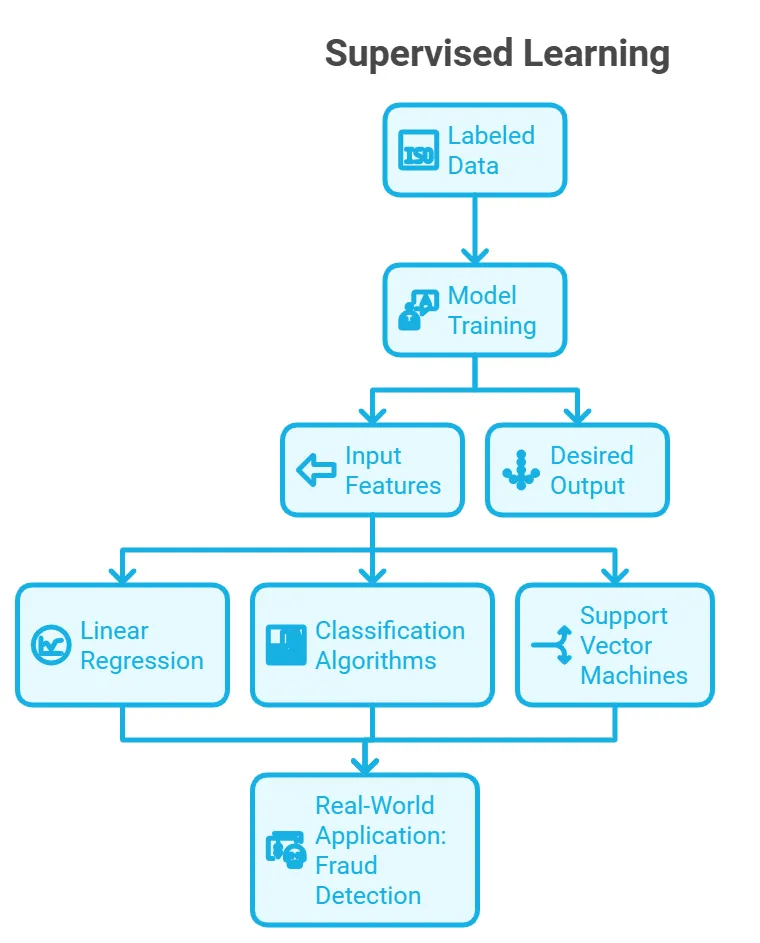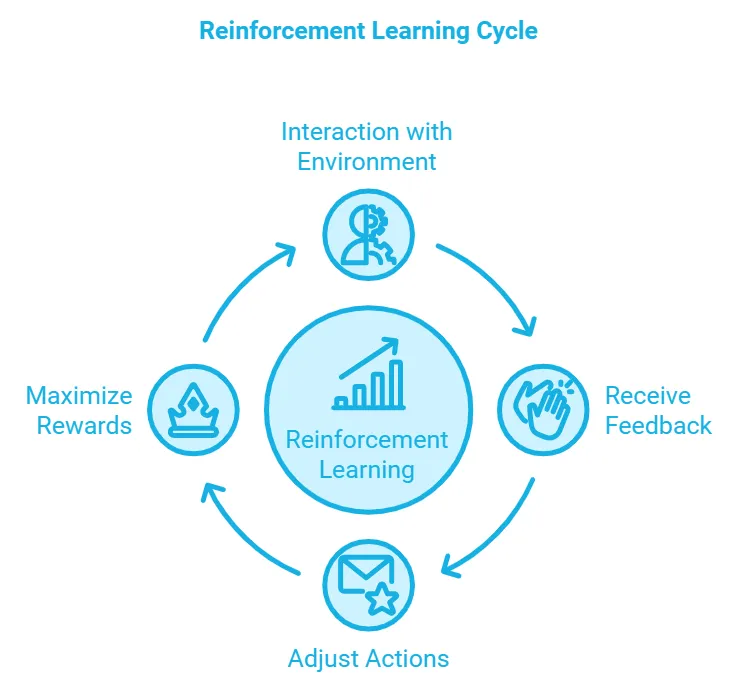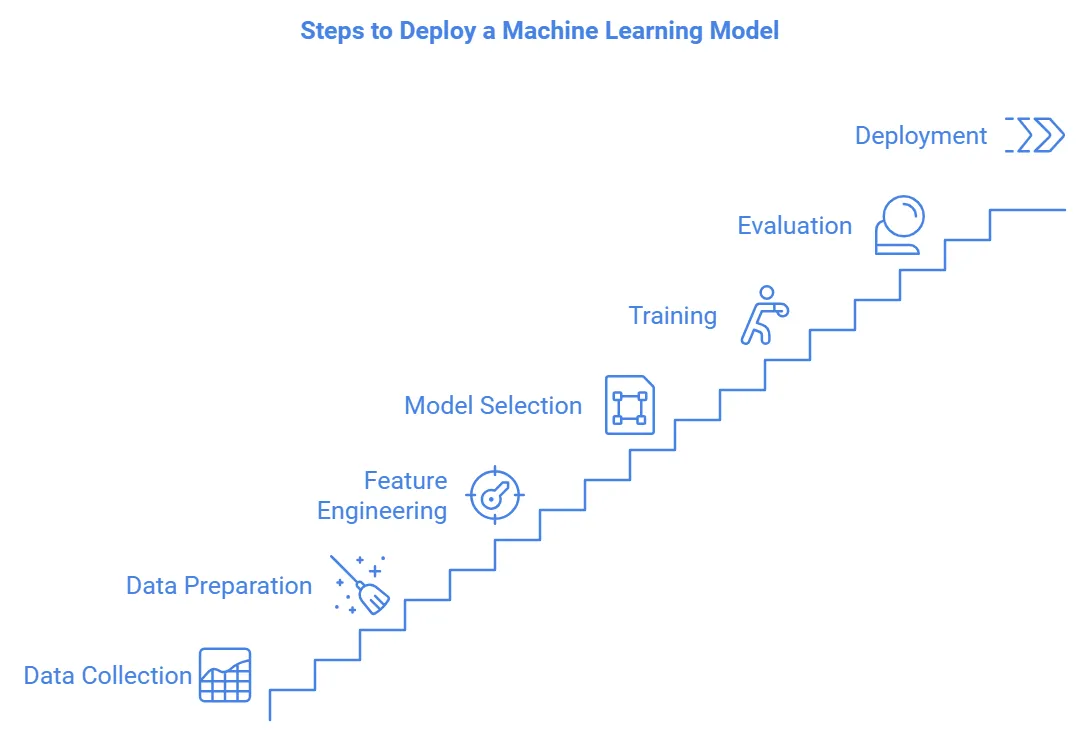Machine learning is changing the way we interact with technology. Machine learning (ML) is at the center of many modern advancements like personalized recommendations on Netflix, self driving cars and virtual assistants like Alexa, Siri etc. But what exactly is machine learning and how does machine learning work?
In this guide we shall discuss the fundamentals of machine learning, along with its main types, machine learning models, key algorithms and applications in various industries.
What Is Machine Learning?
Machine learning is a part of artificial intelligence (AI) that allows computers to learn from data rather than being exclusively programmed. In traditional programming, developers write rules and instructions to guide a system’s behavior. However, with machine learning, a system learns to make decisions based on patterns in data.
Main Concepts in Machine Learning
1. Data: Data is the starting point for any machine learning process. It could be numbers, images, text, or any form of digital information. The algorithm analyzes this data to learn patterns.
2. Algorithms: An algorithm is a set of instructions that a computer follows to solve a specific problem. In machine learning, algorithms analyze data and use it to make predictions or decisions.
3. Training Data: This is the dataset used to ‘teach’ the model. The model learns patterns and associations from this data.
4. Model: A model is the output of a machine learning algorithm after it has been trained on data. It is essentially the learned behavior that can make predictions.
5. Features: Features are the individual measurable properties or characteristics of the data being used.
6. Labels: Labels are the correct outputs or targets, which the model is trying to predict (commonly used in supervised learning).
7. Training and Testing: Training is the process of feeding data into the algorithm so it can learn. Testing is where the algorithm is evaluated to see how well it performs on new, unseen data.
Types of Machine Learning
There are three primary types of machine learning: supervised, unsupervised and reinforcement learning. Each type serves a different purpose and uses various techniques to solve problems.
1. Supervised Learning
In supervised learning, the model is trained on labeled data, which means that each data point is associated with the correct output. The model learns to map input data (features) to the desired output (label).

– Examples of Supervised Learning Algorithms:
– Linear Regression: Used for predicting a continuous value, such as house prices based on size, location or stock prices etc.
– Classification (e.g., logistic regression, decision trees): Used for categorizing data, like classifying emails as spam or not spam.
– Support Vector Machines (SVM): Good for classification in high dimensional spaces, like image recognition.
– Real World Example:
– Fraud Detection in Banking: Banks use supervised learning models to detect fraudulent transactions. The model is trained on past transaction data, where each transaction is labeled as ‘fraudulent’ or ‘legitimate’, which allows it to predict the probability of new transactions being fraudulent.
Applications:
– Healthcare: Diagnosing diseases from medical images (e.g., detecting tumors).
– Finance: Predicting stock prices and credit scoring.
– Retail: Recommendation engines that suggest products based on past purchases.
2. Unsupervised Learning
Unsupervised learning deals with unlabeled data. Here, the model tries to find patterns or groupings within the data without prior knowledge of the output.

– Examples of Unsupervised Learning Algorithms:
– Clustering (e.g., k-means clustering): Groups data into clusters based on similarity.
– Principal Component Analysis (PCA): Reduces the dimensionality of data to highlight important features while preserving its structure.
– Anomaly Detection: Identifies outliers, useful for fraud detection.
– Real World Example:
– Customer Segmentation in Marketing: Companies use clustering algorithms to segment customers into distinct groups based on purchasing behavior, which allows them for targeted marketing.
– Finance: Detecting unusual patterns in transaction data for fraud detection.
– Social Media: Grouping similar users or content for recommendations.
3. Reinforcement Learning
Reinforcement learning is a type of learning where an agent learns by interacting with an environment. It receives feedback in the form of rewards or penalties and adjusts its actions accordingly to maximize cumulative rewards over time.

– Examples of Reinforcement Learning Algorithms:
– Q-Learning: Used for learning policies in environments where an agent interacts with different states and takes actions to maximize rewards.
– Deep Q-Networks (DQN): Combines deep learning with reinforcement learning, commonly used in game playing AI.
– Real World Example:
– Self Driving Cars: Reinforcement learning is used in autonomous vehicles to make decisions in real time. The vehicle (agent) continuously learns to navigate roads, avoid obstacles and make optimal driving decisions.
– Gaming: AI agents that play games and improve by learning from experience.
– Robotics: Robots learning to perform tasks like picking up objects or navigating obstacles.
Common Machine Learning Algorithms
Different algorithms are used based on the type of problem (classification, regression, clustering, etc.). Here are some of the most commonly used algorithms:
1. Linear Regression: Used in supervised learning for predicting continuous outcomes.
2. Decision Trees: Can be used for both classification and regression. Decision trees are simple and interpretable.
3. K-Nearest Neighbors (KNN): Classifies data based on the “k” closest neighbors to the new data point.
4. Support Vector Machines (SVM): Used for classification tasks, SVMs work well when there is a clear margin of separation between classes.
5. Neural Networks: Inspired by the human brain, neural networks are used in deep learning and are capable of handling complex, unstructured data like images and text.
How Machine Learning Models Are Developed
To understand machine learning in action, let us briefly understand the steps involved in developing a machine learning model:

1. Data Collection: Gathering relevant data is the first step. The quality and quantity of data significantly impact the model’s performance.
2. Data Preparation: Raw data is generally noisy and incomplete, so it needs to be cleaned and formatted. This step may involve removing duplicates, handling missing values and scaling variables.
3. Feature Engineering: Identifying and creating important features (variables) that will help the model to learn patterns more effectively.
4. Model Selection: Choosing the right algorithm based on the problem type, such as regression, classification or clustering.
5. Training: Feeding the prepared data into the model so it can learn from it.
6. Evaluation: Testing the model with new data to assess its accuracy and adjust as necessary.
7. Deployment: Implementing the model in real world applications, where it can make predictions or decisions.
Applications of Machine Learning Across Industries
Machine learning is widely used in many industries to solve complex problems and increase efficiency.
1. Healthcare
– Diagnosis and Prediction: Machine learning algorithms are used to predict diseases, analyze medical images to detect diseases like cancer and suggest treatments. For example, Google’s DeepMind created an AI model that can detect eye diseases from scans with high accuracy.
– Personalized Medicine: ML enables personalized treatment plans by analyzing genetic data and previous health records to predict a patient’s response to treatment.
2. Finance
– Fraud Detection: Financial institutions use supervised learning models to detect anomalies in transaction data, to reduce the risk of fraud.
– Algorithmic Trading: Machine learning models analyze market data to and make trading decisions in milliseconds, to maximize profits.
3. Retail
– Recommendation Engines: E-commerce platforms like Amazon use machine learning to recommend products based on a user’s past behavior.
– Inventory Management: Retailers use predictive models to manage stock levels based on seasonal trends, demand forecasting and customer behavior.
4. Marketing
– Customer Segmentation: Clustering algorithms help segment customers into distinct groups for targeted marketing campaigns.
– Predictive Analytics: Marketers use predictive models to forecast customer lifetime value, which enables them to focus on high value customers.
5. Transportation
– Self Driving Cars: Companies like Tesla and Waymo use machine learning for object detection, path planning and real time decision making in autonomous vehicles.
– Route Optimization: Delivery services use machine learning to find the most efficient routes, which reduces costs and delivery times.
Importance of Machine Learning
Machine learning is very important in modern world because of its ability to process large amounts of data quickly and accurately. In this digital age where data is generated at tremendous rate, businesses need to use Machine Learning to make data driven decisions, to enhance customer experiences and stay competitive.
Key Takeaways and Next Steps
Machine learning might seem hard, but understanding the fundamentals can help you to see its potential and applications. Here is a quick recap:
– Machine Learning Types:
– Supervised: Learns from labeled data.
– Unsupervised: Discovers patterns in unlabeled data.
– Reinforcement: Learns through rewards and penalties in an interactive environment.
For those interested in learning more about machine learning, many online courses and resources are available on platforms like Coursera, edX and Udacity. Consider starting with a course that covers ML fundamentals and then gradually move to more advanced topics like deep learning and reinforcement learning.
Conclusion:
Machine learning is a powerful tool that has the potential to transform industries, improve decision making and create personalized experiences. As technology advances, its effect will grow progressively.
Understanding these basics is the first step to understand the full potential of machine learning. For a business owner or a data enthusiast, machine learning is a field worth exploring for growth and prosperity.


